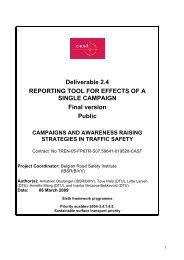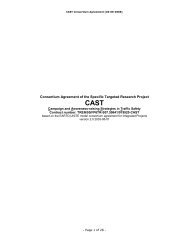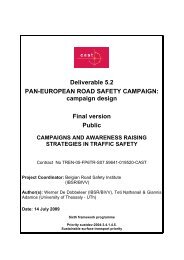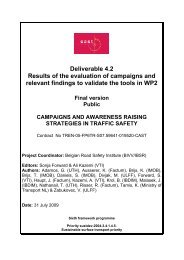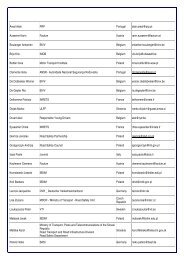Deliverable D 1.3 RESULTS OF META-ANALYSIS ... - cast-eu.org
Deliverable D 1.3 RESULTS OF META-ANALYSIS ... - cast-eu.org
Deliverable D 1.3 RESULTS OF META-ANALYSIS ... - cast-eu.org
You also want an ePaper? Increase the reach of your titles
YUMPU automatically turns print PDFs into web optimized ePapers that Google loves.
Campaigns and awareness raising strategies in traffic safety — <strong>Deliverable</strong> D-1.1Category Variable Coded as…consultationbasis ontheorykind of theorybasis on priorworkuse of riskmessagerisk of harm toselfrisk of harm toothersrisk ofdetectionconsequencesshownshockingeffectshumoursocial normemotional,rational,incentive7.1.2 DATA EXTRACTION0. No, 1. Yes1. Theory of Planned Behaviour (TPB), 2. Theory of Reasoned Action (TRA), 3. SocialLearning theory (Bandura), 4.Peer-eduation method, 5. Behavioural theory, 6. Publicinformation and education model, 7. Public Information & Enforcement and Selective TrafficEnforcement Program (STEP), 8. Self-responsibility, 9. Risk salience link to behaviour, 10.Based on previous work, 11. Organizational Behavior theory, 12 Social marketing0. No, 1. Yes0. No, 1. Yes0. No, 1. Yes0. No, 1. Yes0. No, 1. Yes0. No, 1. Yes0. No, 1. Yes0. No, 1. Yes0. No, 1. Yes0. Emotional, 1. Rational, 2. Both emotional and rational, 3. IncentiveRelevant data were systematically extracted from each study using aspreadsheet. The spreadsheet was designed to capture and structurevariables describing the evaluation study, the delivery of the campaign, thecontent of the campaign, and of course the effects of campaign on theoutcome measure. The spreadsheet was elaborated as the data was collectedin order to capture any aspect of campaign delivery or content that mightinfluence campaign effectiveness.The variables used to structure the spreadsheet are given in Table 7.1, wherethey are also grouped into categories.To attain the large number of results necessary for meta-regression, effectswere included whether or not data for corresponding control groups werereported.The data was coded by a single researcher i.e. there were no checks for interraterreliability.7.<strong>1.3</strong> PROCESSING <strong>OF</strong> STUDY DATAFor each campaign effect, data describing the campaign and its evaluationwere entered into the database. Meta-analysis was used to test whether theeffects reported by controlled and non-controlled designs differed significantlyfor each of the outcome measures. If no such difference was identified, alleffects reported for the outcome measure were included in subsequentanalyses. Meta-analysis was performed to determine the overall effect ofcampaigns according to a specific outcome measure and to inform a metaregressionanalysis. This process is outlined in Chapter 6 and exemplified insome detail in section 7.3.56



